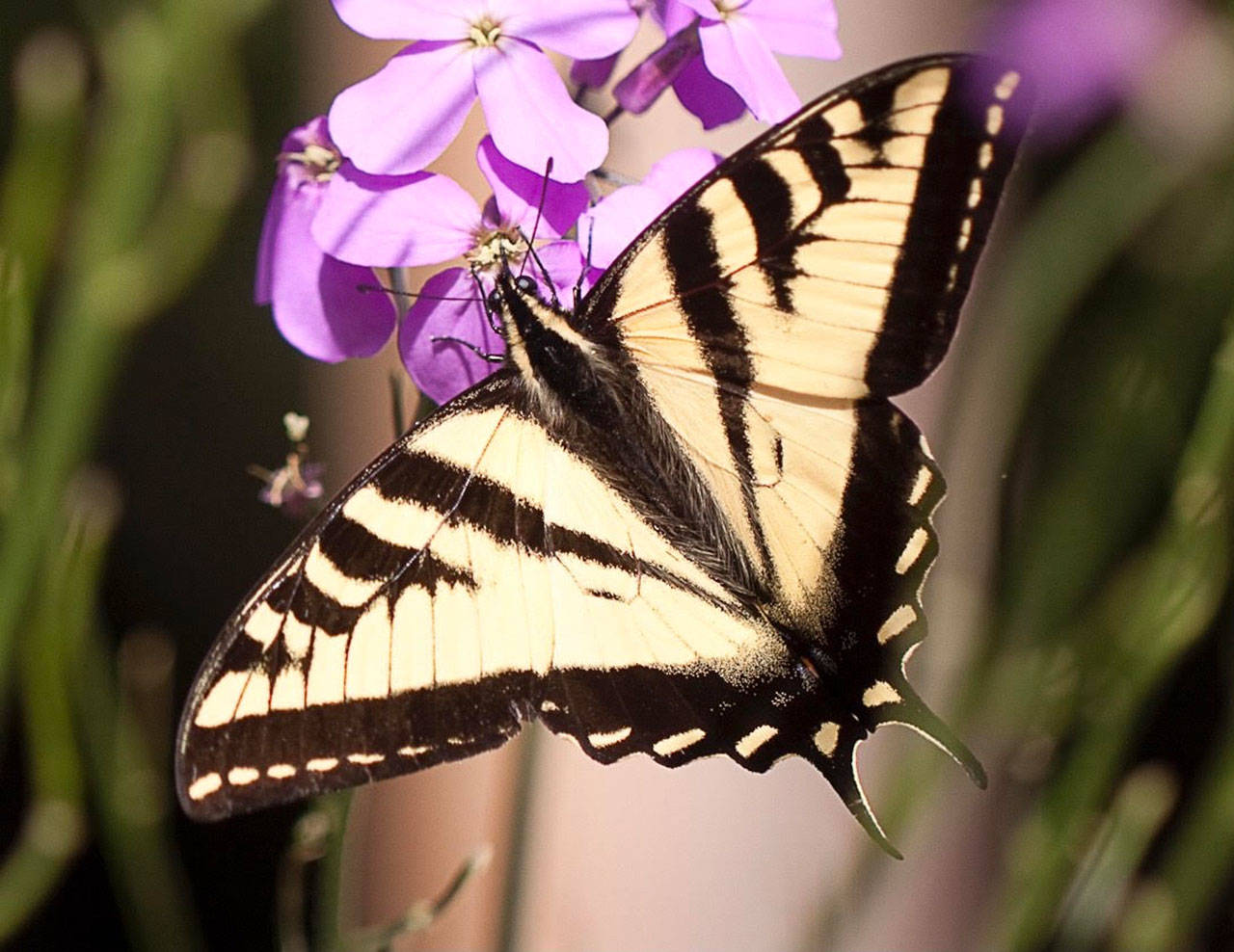The Olympic Peninsula is gifted with a rich array of butterflies. For centuries, butterflies have been admired for their graceful beauty and for their transformation from caterpillar to winged adult. While they make up the second largest order of insects, the Lepidoptera, these elegant creatures play an important role as pollinators for many flowering plants.
In the United States, however, there has been a significant decline in butterfly numbers due to pollution, loss of habitat, food sources, and use of pesticides. So what can people do to protect and save them?
To set the stage for conservation, the needs of a butterfly can be met in any size garden or field. Butterflies are responsive to sunny gardens with a combination of larvae host plants and nectar plants that preserve their four stages of life: egg, larva (caterpillar), chrysalis (pupa) and winged adult.
Attracting multiple species is dependent upon specific mixtures of host and nectar plants. It is essential that the garden is free of herbicides and insecticides. These chemicals can kill the butterflies that are being invited into the garden.
Host plants, such as Oceanspray (Holodiscus discolor) or Manzanita (Arctostaphylos), are needed for the adult butterfly to lay her eggs. Once the eggs have hatched, the host plant supplies nourishment for the hungry larvae. During the course of food consumption, larvae will shed (molt) their exoskeleton up to six times to accommodate for their size increase.
In the final stage of molting, the larvae will finish eating and will find safe places to transform into chrysalides (pupae).
Since the chrysalis is immobile during this stage, it is camouflaged to match its surroundings for protection from predators. Many chrysalides are leaf shaped and vary in color.
Once the metamorphosis from caterpillar to adult is complete, the butterfly will emerge from the chrysalis as sexually mature and with fully developed wings. Before taking flight, they allow their wings to harden and dry.
When the adult is ready to fly, the butterfly will need warmth and sunshine in its search for food. Their primary food sources are energy-rich nectar plants. Not only do these plants sustain the life of butterflies, bees, and other wildlife, but they provide color, texture, and beauty to any garden.
To support a variety of butterflies, select an assortment of nectar plants that will bloom throughout the growing seasons. Camassia (Camas), beardtongue (Penstemon), red osier dogwood (Cornus sericea), and gloriosa daisy (Rudbeckia species) are examples of excellent nectar plants.
Group similar nectar species en masse and place near the host plants so the newly emerged butterfly does not have far to travel for food.
Beware of plants that are noxious weeds or aggressive in their growth pattern. The nonnative plant, butterfly bush (Buddleja davidii), is enjoyed by butterflies, however, it is considered a noxious weed in Washington. It spreads aggressively and will crowd out other plants that butterflies rely on.
Provide large rocks, bricks, or pavement in the garden for butterflies to perch upon. While basking in the sun, they will spread their wings open to raise their body temperature. Supply a water source such as a puddle or shallow plate where butterflies can obtain mineral salts.
The shape and color of flowers are important to butterflies. Choose plants that have large, compact flat heads, such as Coneflower (Echinacea) and those with clusters of tubular flowers such as Columbine (Aquilegia).
Butterflies largely prefer flowers that are yellow, purple, red, pink, or orange. Avoid hybrid flowers that produce showy flowers. They use the term “double” and are not good sources of nectar. Instead, use single-flower varieties.
In designing a butterfly garden, consider the following larvae host and nectar plants for these butterflies on the Olympic Peninsula:
Western tiger swallowtail
Often mistaken for Monarchs, which do not live on the Olympic Peninsula.
Host plants: Serviceberry (Amelanchier alnifolia), willow (Salix)
Nectar plants: Black-eyed Susan (Rudbeckia hirta), native honeysuckle (Lonicera ciliosa), anise hyssop (Agastache foeniculum)
Spring Azure
Host plants: Red osier dogwood (Cornus sericea), ninebark (Physocarpus)
Nectar plants: Currants, blackberry, rock cress (Arabis)
Painted Lady
Host plants: Thistle (Cirsium discolor), mallow (Sidalcea virgata)
Nectar plants: Oregon-grape (Mahonia aquifolium), Zinnia
Clodius Parnassian
Host plants: Pacific bleeding heart (Dicentra formosa)
Nectar plants: Blackberry
Woodland Skipper
Host plants: Grasses
Nectar plants: Black-eyed Susan (Rudbeckia hirta), Aster, lavender (Lavendula)
Read up on butterflies
For more information about butterflies, refer to:
“Butterflies of the North Olympic Peninsula” field guide by Kristi Murray Knowles.
“Gardening for Butterflies” by the Xerces Society
“Butterflies of Clallam County” (dungenessrivercenter.org/park/ecosystems/butterflies-of-clallam-county)
Loretta Ferguson is a Clallam County Master Gardener.



